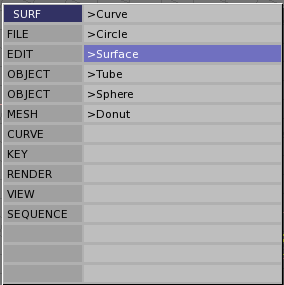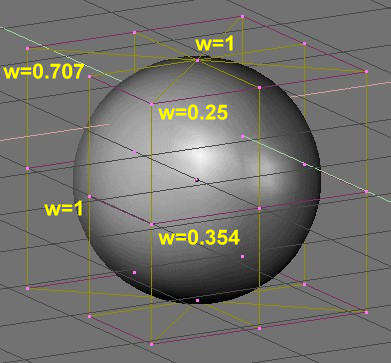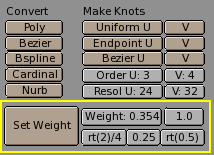Surfaces
Surfaces are actually an extension of NURBS curves. In Blender they are a separate ObData type. Whereas a curve only produces one-dimensional interpolation, Surfaces have a second extra dimension, the first called U, as for curves, the second V.
A two-dimensional grid of control points defines the form for these NURBS surfaces.
Use Surfaces to create and revise fluid curved surfaces. They can be cyclical in both directions, allowing you to easily create a 'donut' shape. Surfaces can also be drawn as 'solids' in EditMode (zbuffered, with OpenGL lighting). This makes working with surfaces quite easy.
Currently Blender has a basic tool set for Surfaces. It has limited functionality regarding the creation of holes and the melting of surfaces. Future versions will contain increased functionality in these areas.
You can take a surface 'primitive' from the ADD menu as a starting point Figure 20. NURBS curves are intrinsically NURBS Surfaces, simply having one dimension neglected. That's why you can choose 'Curve' from the 'Surface' Menu!
Beware anyway that a NURBS 'true' curve and a NURBS 'surface' curve are not interchangeable, as it will be clear for the extruding process described below and for the skinning section further on.
If you add a 'surface' curve you are then able to create a true surface simply by extruding the entire curve (EKEY). Each edge of a surface can then be extruded any way you wish to form the model. Use CKEY to make the U or V direction cyclic. It is important to set the 'knots' to "Uniform" or "Endpoint" with one of the pre-sets from the EditButtons.
A surface becomes active if one of its vertices is selected with the RMB. This causes the EditButtons to be re-drawn.
When working with surfaces, it is handy to always work on a complete column or row of vertices. Blender provides a selection tool for this: SHIFT+R, "Select Row". Starting from the last selected vertex, a complete row of vertices is extend selected in the 'U' or 'V' direction. Choose Select Row again with the same vertex and you toggle between the 'U' of 'V' selection.
NURBS are able to create pure shapes such as circles, cylinders and spheres. Beware that a Bézier circle is not a pure circle.
To create pure circles, globes or cylinders, you must set the weights of the vertices. This is not intuitive, and you are strongly advised to read more on NURBS first. Basically: to get a circular arc from a curve with 3 control points, the end points must have a unitary weight, and the central a weight equal to half the cosine of half the angle between the segments joining the points. Figure 21 shows this for a globe. Three standard numbers are included as pre-sets in the EditButtons (Figure 22). To read the weight of a vertex, once it is selected, press the NKEY.


